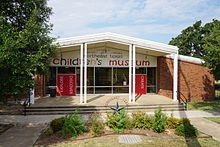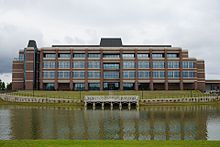Northeast Texas
Northeast Texas | |
|---|---|
 | |
| Country | |
| State | |
| Population | |
| • Total | 1,115,000 |
Northeast Texas is a region in the northeast corner of the U.S. state of Texas. It is geographically centered on two metropolitan areas strung along Interstate 20: Tyler in the west and Longview/Marshall to the east. Mount Pleasant, Sulphur Springs, Paris and Texarkana in the north primarily along Interstate 30, Jacksonville and Palestine to the south are also major cities within the region. Most of Northeast Texas is included in the interstate region of the Ark-La-Tex.
Its climate is warmer and wetter than most of Texas and its geography is more hilly and forested. Its culture is similar to that of Southeast Texas, but does not have as much of a Cajun influence. Many of the largest cities in Northeast Texas outside Dallas still follow a rural Southern way of life, especially in dialect, mannerisms, religion, and cuisine.
Geography[]
The geography is composed mainly of the Piney Woods, a mixed forest of deciduous and conifer flora. The Piney Woods cover 23,500 sq mi (61,000 km2) of gently rolling or hilly forested land. These woods are part of a much larger region of pine-hardwood forest that extends into Louisiana, Arkansas, and Oklahoma. Northeast Texas lies within the Gulf Coastal Plain and receives more rainfall, 35 to 50 in (890 to 1270 mm), than the rest of Texas.
The Sabine River is the major river in Northeast Texas, and flows through Longview and several other cities. The Red River also flows through the region and forms the northern border with Oklahoma and a portion of Arkansas. In Northeast Texas and the rest of South, small rivers and creeks collect into swamps called "bayous" and merge with the surrounding forest. Bald cypress and Spanish moss are the dominant plants in bayous. The most famous of these bayous in Northeast Texas is the Cypress Bayou surrounding the Big, Little, and Black Cypress Rivers around Jefferson. They flow east into Caddo Lake and the adjoining wetlands cover the rim and islands of the lake.
Some of the major lakes in the area include: Jim Chapman Lake, Lake Tawakoni, Lake Fork, Cedar Creek Reservoir, Pat Mayse Lake, Lake Palestine, Caddo Lake, Lake O' the Pines, and Wright Patman Lake.
Major highways[]

 Interstate 20
Interstate 20 Interstate 30
Interstate 30 U.S. Highway 59
U.S. Highway 59 U.S. Highway 67
U.S. Highway 67 U.S. Highway 69
U.S. Highway 69 U.S. Highway 79
U.S. Highway 79 U.S. Highway 80
U.S. Highway 80 U.S. Highway 82
U.S. Highway 82 U.S. Highway 84
U.S. Highway 84 U.S. Highway 175
U.S. Highway 175 U.S. Highway 259
U.S. Highway 259 U.S. Highway 271
U.S. Highway 271 U.S. Highway 287
U.S. Highway 287
Counties in Northeast Texas[]
According to the Northeast Texas Genealogical Society, these 23 counties comprise Northeast Texas:[1]
Largest cities[]
| City | Population (2010) |
|---|---|
 Tyler |
96,900
109,619 (2021)[2] |
 Longview |
80,455
82,511 (2021)[3] |
 Texarkana |
66,330
TX portion: 36,411 AR portion: 29,919 |
 Paris |
25,171 |
 Marshall |
23,523 |
 Palestine |
18,712 |
 Mount Pleasant |
15,564 |
 Sulphur Springs |
15,449 |
 Jacksonville |
14,544 |
 Henderson |
13,712 |
 Kilgore |
12,975 |
 Athens |
12,710 |
Culture[]


Culturally, Northeast Texas is more closely akin to Arkansas, Louisiana, and even Mississippi than it is to West Texas. Northeast Texas is in the Bible Belt creating a strong Fundamentalist Christian sentiment. Though 35% of Texas's population is now Hispanic, African-Americans are still the most populous minority in Northeast Texas. During the Civil Rights Movement several communities clashed over integration. In presidential elections since 1950, both Smith County (county seat Tyler) and Gregg County (county seat Longview) have been reliably Republican.
Much of modern Northeast Texas culture has its roots in traditions that go back for generations. First Monday Trade Days is a monthly flea market held in Canton, Texas. The market is actually held on the Thursday through Sunday preceding the first Monday of each month. It purports to be the largest and oldest continually operated flea market in the United States, and is a popular event in the area.
The East Texas Oil Museum, located on the campus of Kilgore College in Kilgore, Texas, houses the authentic recreation of oil discovery and production in the early 1930s from the largest oil field inside U.S. boundaries.
Tyler has a rich culture and has been nicknamed the "Rose Capital of America" because of its large role in the rose-growing industry; about 20% of commercial rose bushes produced in the U.S. are grown in Tyler and Smith Counties and more than half of the rose bushes are packaged and shipped from the area. It boasts the nation's largest municipal rose garden and hosts the Texas Rose Festival each October, which draws more than 100,000 spectators annually.
The Northeast Texas Children's Museum is located in Commerce. The museum provides playful and creative learning experiences for children in the Northeast Texas area. Many school districts from the Dallas/Fort Worth Metroplex and the Northeast Texas area take field trips to the museum.
Higher education[]

Northeast Texas has a number of higher-education institutions, including The University of Texas at Tyler, Texas A&M University at Commerce, Texas A&M University at Texarkana, Stephen F. Austin State University located in Nacogdoches, East Texas Baptist University, LeTourneau University, eight public and two private community colleges, a branch of the Texas State Technical College at Marshall, three historically black colleges, and a number of church-affiliated private institutions. The public colleges and universities of the region also collaboratively provide degree and course opportunities through the Northeast Texas Consortium of Colleges and Universities.
The community colleges of Northeast Texas share a history of emerging from the "junior college" movement of schools focused on providing the first two years of the college degree. Although most added technical programs with associate of applied science degrees following the community college movement of the 1960s, the schools still place a strong emphasis on liberal arts and the academic associate of arts and associate of science degree programs. They often include the full range of college sports, including football, and host dormitories, and are known for their "high kicking" drill teams. Community colleges in the region include Kilgore College, Paris Junior College, Northeast Texas Community College near Mt. Pleasant, Texarkana College, Panola College in Carthage, Tyler Junior College, Trinity Valley Community College in Athens and with campuses in Terrell and Palestine, and Angelina College in Lufkin. Jacksonville hosts the two smaller private two-year colleges of the region, Jacksonville College (Baptist) and Lon Morris College.
Regional evolution[]

The region is unique in that it is the only portion of East Texas that is not within the direct sphere of influence of either Dallas/Fort Worth or Houston. This generally weakens the area's visibility as areas in the far south ally themselves with Houston and areas to the west ally themselves with Dallas. These areas are on the fringe of those cities' spheres of influence, so are not as visible as smaller cities such as Grapevine or Deer Park, which are closer to the respective centers of power.
In the mid-19th century, Marshall and Jefferson constituted a sphere of influence that led the entire state into the Confederacy, and during the Mexican and Republic periods, Nacogdoches and San Augustine were the most developed and influential cities in Northeast Texas. Nacogdoches rebelled against Mexican rule in the Fredonian Rebellion and had one of the first newspapers to run the phrase Remember the Alamo!. While none of these three cities is a major population center, in its own right on the state level any longer, all four are still major cultural centers, with Nacogdoches and Tyler being well-established centers of higher learning.
Today, Tyler and Longview are the largest cities in Northeast Texas. The Tyler MSA had 209,714 people, and the Longview MSA had 206,874 people in 2010. Tyler has succeeded in establishing itself as the regional hub due to its expansive medical and higher-education communities. Tyler has a general partnership with Jacksonville, while Longview has leaned more toward cooperation with its traditional rival Marshall. The Texarkana MSA is another large metropolitan area in the region, with over 143,486 people. It is in the far northeast corner of Texas and southwest corner of Arkansas straddling the Texas/Arkansas border.
In the last decade of the 20th century and first decade of the 21st century, many of the cities of Northeast Texas began to cooperate by forming organizations dedicated to a single agenda of common interest, such as the North East Texas Tourism Council and Northeast Texas Air Care.
See also[]
Footnotes[]
- ^ Northeast Tx Genealogical Society http://freepages.genealogy.rootsweb.ancestry.com/~netex/netexas/index.htm
- ^ "Tyler, Texas Population 2021 (Demographics, Maps, Graphs)".
- ^ "Longview, Texas Population 2021 (Demographics, Maps, Graphs)". worldpopulationreview.com. Retrieved 2021-03-07.
External links[]
- Northeast Texas Air Care
- ETMC Regional Healthcare System (Tyler-based)
- Good Shepherd Health System (Longview/Marshall)
- North East Texas Tourism Council
- Northeast Texas Consortium of Colleges & Universities (NETnet)
- East Texas Virtual Village
- North East Texas Information and Reviews
- Franklin County Genealogical Society
- Regions of Texas
